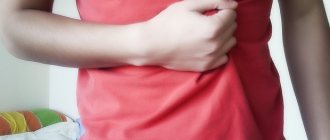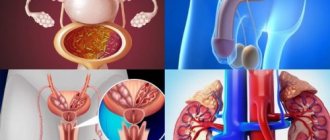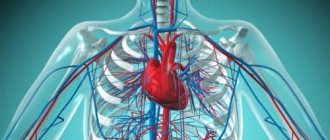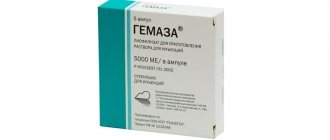Indications for starting treatment
The product is intended for the treatment of sinusitis (inflammatory processes in the paranasal sinuses). A unique homeopathic anti-inflammatory remedy is indicated to be taken if the patient is diagnosed with diseases such as:
- frontal sinusitis (acute or chronic);
- sinusitis (chronic or in the acute stage).
Some patients have a question: Sinupret or Cinnabsin, which is better? These products differ in composition. In each specific case, the choice of drug is best left to the discretion of the attending physician.
Pharmacological properties
The drug is used for the symptomatic treatment of inflammatory processes in the paranasal sinuses. The active component of Cinnabaris suppresses pain, suppresses lacrimation, and eliminates the symptoms of facial neuralgia. Hydrastis and Kalium bichromicum are especially active in the acute and subacute periods during chronic or prolonged sinusitis. All three of the above-mentioned active components of Cinnabsin help relieve swelling of the mucous membrane, which subsequently leads to the complete restoration of nasal breathing.
How to take Cinnabsin. Optimal dosages
Therapy of acute inflammatory processes in the paranasal sinuses involves regular intake of Cinnabsin (with an interval of 60 minutes). The tablets should be slowly dissolved half an hour before meals or half an hour after finishing a meal. Treatment should be continued until symptoms subside. The maximum daily dosage is 8 tablets. Until complete recovery, the patient needs to take maintenance doses (1-2 tablets 3 times a day).
Chronic sinusitis requires a long course of treatment. In this case, a homeopathic drug can be included in combination therapy.
Cinnabsin tablets packaging No. 100
Cinnabsin General physical and chemical properties Tablets are white or almost white, flat, with a beveled edge, slight mottling is possible.
Composition of the medicinal product 1 tablet contains: active substances: Cinnabaris (cinnabar) trit. D3 25 mg, Hydrastis (canadian goldenseal) trit. D3 25 mg, Kalium bichromicum (potassium bichromate) trit. D3 25 mg, Echinacea (echinacea) trit. D1 25 mg; excipients: lactose monohydrate, magnesium stearate, wheat starch.
Release form Tablets.
Pharmacotherapeutic group Homeopathic medicine
Scope of application Homeopathic medicine without approved therapeutic indications. Traditionally used in complex therapy of acute and chronic inflammation of the paranasal sinuses (sinusitis).
Contraindications Cinnabsin should not be taken by persons suffering from an allergy (hypersensitivity reaction) to chromium preparations, echinacea (rudbeckia), other plants of the Asteraceae/Compositae family, or other ingredients in the drug. You should also not take Cinnabsin if you have the following diseases: progressive systemic diseases such as tuberculosis, leukemia and leukemia, autoimmune diseases (inflammatory connective tissue diseases - collagenosis, multiple sclerosis), immunodeficiency (AIDS, HIV infection), immunosuppression (for example, after organ or bone transplantation, chemotherapy), chronic viral diseases. Wheat starch may contain traces of gluten, so caution should be used when treating patients with celiac disease. The drug should not be prescribed if you have a known allergy to starch (a condition other than celiac disease). Do not use Cinnabsin to treat children under 2 years of age.
Interactions with drugs Interactions with other drugs are not known. Treatment with homeopathic medicines does not exclude the use of other medicines.
Special warnings and special precautions If you develop swelling of the face, fever, severe headache, persistent, unexplained or new symptoms, you should consult a doctor. If your doctor has told you that you have an intolerance to any sugars, talk to your doctor before you start taking Cinnabsin. By analogy with all other pharmaceutical drugs, Cinnabsin can be taken during pregnancy and lactation only after prior consultation with a doctor. Wheat starch may contain traces of gluten, so caution should be used when treating patients with celiac disease.
Pregnancy and breastfeeding Since there is insufficient clinical data on the use of the drug during pregnancy and lactation, the drug should be used only after prior consultation with a doctor.
Impact on the ability to drive vehicles and work with special equipment No effect.
Dosage regimen and method of administration In the absence of other instructions from the doctor, Cinnabsin is used as follows. In the acute course of the disease, adults and children over 12 years of age take 1 tablet every hour (but not more than 6 tablets per day). Increasing the duration of treatment for more than one week in the specified regimen or increasing the daily dose is possible only after consultation with a doctor. Children from 2 to 5 years old, after consulting a doctor, take a daily dose that is two times less than the dose for adults (no more than 3 tablets per day). Children from 6 to 11 years old take two-thirds of the adult dose per day (no more than 4 tablets per day). As the condition improves, the frequency of dosing should be reduced. For chronic diseases: adults and children over 12 years old take 1 tablet 1-3 times a day. The tablets should be taken half an hour before meals or half an hour after meals, allowing them to slowly dissolve in the mouth. In young children, it is necessary to dissolve the tablet in a small amount of water before taking it. Cinnabsin should not be taken for more than 8 weeks without consulting a doctor. The harmful effects of an overdose of Cinnabsin are not known to date.
Side effects In some cases, hypersensitivity reactions (for example, skin rashes) and gastrointestinal disorders (nausea and vomiting) may occur. In patients receiving other Echinacea-containing drugs, allergic reactions were observed (skin rashes, itching, in rare cases - swelling of facial tissues, shortness of breath, dizziness, decreased blood pressure). If such side effects develop, you should stop taking the drug and consult your doctor. If salivation increases after taking Cinnabsin, it is recommended to reduce the dose or stop taking the drug. When taking homeopathic medicines, a transient increase in existing symptoms of the disease (initial worsening) is possible; in this case, you should stop taking the drug and consult your doctor. If side effects occur, consult your doctor or pharmacist. Consultation should also be sought in case of side effects not listed in the package insert.
Shelf life: 5 years. The expiration date is indicated on the packaging and label. Do not use the drug after this date.
Storage Store in original packaging at a temperature of 15C to 25C out of the reach of children.
Packaging and contents: 5 blisters of 20 tablets each are packaged in a cardboard box with a patient leaflet.
Dispensing category Dispensed without a prescription.
Contraindications
The product should not be taken by persons who are hypersensitive to its active or auxiliary components. Hypersensitivity to preparations from plants belonging to the Asteraceae family is also a contraindication.
Contraindications also include:
- collagenoses;
- multiple sclerosis;
- leukemia;
- immunosuppression (with HIV or during cancer chemotherapy);
- condition after transplantation;
- gluten intolerance (an additional component is starch);
- congenital deficiency of the enzyme lactase (contains milk sugar).
Contraindications and side effects
Cinnabsin for children (reviews of the product help evaluate its effect before use) and adults is not used when diagnosing intolerance to the active components or a tendency to allergic reactions.
There are other contraindications for use:
- Severe liver failure with severe impairment of organ functioning.
- Inflammatory kidney diseases, severe forms of glomerulonephritis, pyelonephritis, renal failure.
- Leukemia in acute form.
- Pathologies accompanied by immunodeficiency. For HIV infection and AIDS, the drug is not prescribed, since its effect on the body can be unpredictable.
- The recovery period after chemotherapy, when the immune system is suppressed and immunostimulants can provoke complications.
- Severe multiple sclerosis, in which there is significant deterioration in the musculoskeletal system.
- Tuberculosis in acute and chronic form.
- The rehabilitation period after bone marrow or internal organ transplantation.
- Intolerance to plants from the Asteraceae family.
- Tablets are not prescribed to patients under 3 years of age.
With extreme caution, the medicine is prescribed to elderly patients suffering from cardiac and vascular pathologies. The remedy can provoke deterioration, as well as complications, so you should first consult with a specialist.
If the instructions for using the medication are not followed, it can provoke the development of adverse reactions from internal organs and systems. However, complications are not excluded even if all the rules are followed.
| Organs and systems | Common complications in adults and children |
| Nervous system | During treatment, headaches, dizziness and weakness may occur due to the influence of herbal components. In isolated cases, the condition worsens, impaired consciousness and even hallucinations are observed. As a rule, such manifestations occur in adults; children suffer from complications much less frequently. If you stop taking the pills, there is a slight improvement, but symptomatic therapy is usually required. |
| Digestive tract | Increased salivation and heartburn occur frequently during therapy. Sometimes there is a weakening of appetite and indigestion, accompanied by constipation or frequent loose stools. The patient may feel pain in the stomach and intestines, which increases with eating and physical activity. Taking adsorbents does not help get rid of symptoms. |
| Musculoskeletal system | Muscle weakness and joint pain are considered common problems when taking homeopathic remedies. Typically, discomfort is localized in the area of large joints, in the area of the knee, shoulder and hip joints. |
| Skin and mucous membranes | On the part of the skin, disorders do not appear so often. However, if you are allergic to the medication, a small rash may appear on the skin of the torso, limbs, and face. The rash is accompanied by severe itching, burning and peeling of the skin. Symptoms worsen in the absence of specific therapy. |
The severity of adverse reactions may vary, depending on the individual characteristics of the body. Children suffer from complications less often, but they are difficult to tolerate and complex therapy is almost always required.
How does Cinnabsin work?
Cinnabsin is characterized by powerful anti-inflammatory properties. In addition, the product can strengthen human immunity. The therapeutic effect is due to the complex effect of the natural ingredients included in its composition. A modern homeopathic remedy makes it possible to reduce the degree of swelling of the mucous membranes of the paranasal sinuses and nose in a relatively short period of time, thereby restoring nasal breathing. It is noted that taking the tablets also helps combat symptoms characteristic of sinusitis such as headache, lacrimation and trigeminal neuralgia.
Crushed dried rhizome of the Canadian yellow root, as well as potassium dichromate, help if there is a chronic inflammatory process or subacute sinusitis. Under the influence of these components, the level of formation of secretion and exudate in the mucous membranes of the paranasal sinuses is significantly reduced. Red mercury sulfide is most effective in the early stages of the disease. Echinacea plant extract is a powerful immunostimulant and immunomodulator. This component of the combined agent allows you to reduce the frequency of recurrence of inflammation of the paranasal sinuses.
When the tablets are dissolved, the active components are absorbed into the systemic circulation extremely quickly. The ingredients practically do not undergo biotransformation and are excreted from the body in a non-metabolized and non-conjugated form.
Mechanism of action
Cinnabsin for children (reviews of the drug may be negative, which is due to the characteristics of each patient’s body) and adults can be used due to its unique pharmacological properties. The product has a pronounced anti-inflammatory effect due to the content of herbal and natural components.
The mechanism of action of the drug is based on the ability of echinacea extract and other components to influence the development of inflammation in the body.
The substances block components that provoke inflammation, which leads to a significant improvement in the patient’s condition and slows down the progression of the disease. As a result, there is a gradual restoration of the affected tissues and cell renewal.
In addition, echinacea extract has pronounced immunostimulating properties and stimulates the formation in the body of cells responsible for the absorption of pathogens.
This leads to strengthening the immune system, improving the patient’s condition and toning the body. After completing the course of therapy, the patient feels much better, even in the case of chronic pathology.
It is worth noting that the action of the medication is also aimed specifically at the treatment of respiratory diseases. The components of the composition affect the mucous membrane of the nasopharynx, which leads to the elimination of inflammation, swelling and other unpleasant manifestations.
Additionally, the medication has a positive effect on nervous tissue, which leads to the elimination of neuralgia and neuritis of various origins. Experts draw patients’ attention to the fact that in chronic forms of inflammation the drug is more effective, but its use in acute pathologies is not contraindicated.
The components not only eliminate swelling and inflammation of tissues, but also prevent the development of microbes on them, which promotes rapid recovery and reduces the risk of complications.
When used for a long time, cell and tissue renewal occurs, nasal breathing improves, and the manifestations of chronic respiratory diseases are eliminated. The immune system is additionally strengthened, which helps the body fight new microbes entering from the external environment.
When taking a tablet, its dissolution occurs in the oral cavity. The active components are released and enter the systemic circulation. Since the product contains only natural ingredients, processing in the body occurs quite quickly, and the substances are metabolized almost completely in the digestive tract.
The maximum concentration in the blood is detected 3-4 hours after consumption; a constant amount of ingredients in the plasma is detected only a few days after the start of treatment. The ingredients do not accumulate in the blood or tissues, which significantly reduces the risk of overdose, but does not completely eliminate it.
The active substances are removed from the body within 1 day after the termination of the therapeutic course. The main amount is excreted through the kidneys, a small part - with feces. In patients who suffer from severe liver and kidney pathologies, the absorption and excretion of substances in the body slows down.
In the body of children, the drug is absorbed and processed faster. Adults note a slower onset of the therapeutic effect, which is associated with a deterioration in the absorption of the active components.
Are there analogues of Cinnabsin?
This medication has no analogues that are identical in composition. However, there are many other drugs that have similar effects. Among them are Nasonex, No-Sol, Dolphin, Euphorbium compositum, Asinis, Snoop, Rinostop, Adrianol and others.
Conclusion: Cinnabsin tablets are a popular remedy for sinusitis, sinusitis, sinusitis and adenoids. Safe and effective, it will help get rid of unpleasant symptoms, strengthen the immune system and reduce the likelihood of relapses.
Previous Staphylococcal bacteriophage - a real alternative to antibiotics or a drug with questionable effectiveness?
Next Euphorbium compositum is a homeopathic remedy for the common cold. To fear or to trust?
Which is better: Sinupret or Cinnabsin?
The choice of tablets for the common cold today is large.
Sometimes doctors prescribe two drugs at once (in case one is not available at the pharmacy). Sinupret and Cinnabsin are just such a case. But the alternative doesn't make the choice any easier. Rather, on the contrary, it makes you seriously think about what to buy: Sinupret or Cinnabsin? First of all, it should be emphasized that the question “which is better” is not entirely correct. These are different medicines. And each has its own advantages.
Sinupret is not a homeopathic, but a highly effective herbal preparation. Contains gentian, primrose, verbena, sorrel grass. Used when there is viscous secretion in the nasal sinuses. The tablets are not given to children under 6 years of age. The maximum duration of treatment is 2 weeks.
Cinnabsin is a homeopathic remedy that is effective in combating chronic and acute infections. Not prescribed for children under 3 years of age. Can be used for a long time (2-3 months or more).
special instructions
In some cases, when using homeopathic medicines, there is some deterioration in the condition. In case of exacerbation of the disease caused by taking Cinnabsin, it is recommended to immediately stop the course of treatment and seek advice from your doctor.
Cinnabsin contains wheat starch, so patients with hypersensitivity or intolerance to gluten should not take the drug.
Due to the lack of confirmed experimental and clinical data, it is not recommended to take the drug for children under two years of age.
Is Cinnabsin safe for children?
This is a completely natural question for parents. Many people are confused by the composition of this medicine (in particular the presence of mercury). There's no need to worry about this.
Repeated dilution leads to the loss of materiality by the molecules. As homeopaths say, only information about the “source” remains.
The instructions for use for Cinnabsin state that the drug can be prescribed to children from 3 years of age. At night it will relieve the baby from restless sleep associated with nasal congestion, and during the day it will return the joy of learning about the world around him. The tablets help well with chronic sinusitis, runny nose and adenoids.
We advise you to study: Farmazolin - inexpensive and highly effective drops. But why are so many patients unhappy?
Why is homeopathy controversial?
In Europe, homeopathy is actively used to treat various pathological conditions. It seems quite successful. In our country, Samuel Hahnemann’s method is viewed with skepticism. And all because it is not entirely clear how it is to treat like with like.
Lack of information creates doubts among patients. Some do not believe in the possibility of healing with the help of medicinal microdoses, others are sure that homeopathy is nothing more than an opportunity to pump money out of them, and still others are afraid of drugs containing “dangerous” substances.
In fact, homeopathy (with the right approach) can be one of the best ways to eliminate various ailments. Effective and at the same time absolutely safe. The main thing is that the treatment is carried out by a qualified specialist, and not by the grandmother from the next door.









